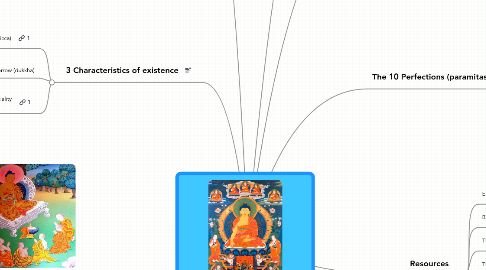
1. The 5 Aggregates
1.1. What we are made up of. The five aggregates (skandas) are:
1.1.1. Form (rupa)
1.1.1.1. which is made up of:
1.1.1.1.1. Earth
1.1.1.1.2. Water
1.1.1.1.3. Fire
1.1.1.1.4. Wind
1.1.2. Feeling (vedana)
1.1.2.1. is one of:
1.1.2.1.1. Pleasant
1.1.2.1.2. Unpleasant
1.1.2.1.3. Neutral
1.1.2.2. Feelings arise when there is contact between the six internal organs and the six external objects.
1.1.2.2.1. Internal Organs
1.1.2.2.2. External objects
1.1.3. Perception (samjna)
1.1.3.1. is related to the six external objects
1.1.4. Volition (samskara)
1.1.4.1. is the response of the will to the six external objects
1.1.5. Consciousness (vijnana)
1.1.5.1. grasps the characteristics of the six external objects
1.1.5.1.1. Visual consciousness
1.1.5.1.2. Auditory consciousness
1.1.5.1.3. Olfactory consciousness
1.1.5.1.4. Gustatory consciousness
1.1.5.1.5. Tactile consciousness
1.1.5.1.6. Mental consciousness
2. Core Concepts - Four Noble Truths
2.1. 1. Suffering exists
2.2. 2. Suffering arises from attachment to desires
2.3. 3. Suffering ceases when attachment to desire ceases
2.4. 4. Freedom from suffering is possible by practicing the Eightfold Path
2.4.1. Noble Eightfold Path
2.4.1.1. Three Qualities
2.4.1.1.1. Wisdom (panna)
2.4.1.1.2. Morality (sila)
2.4.1.1.3. Meditation (samadhi)
3. 3 Characteristics of existence
3.1. Impermanence or Transiency (anicca)
3.1.1. Everything is limited to a certain duration and, consequently, liable to disappear.
3.2. Sufferings or Sorrow (dukkha)
3.2.1. Existence is filled with sufferings, worries, dissatisfactions of all kinds, and that these never stop.
3.3. Selflessness or Insubstantiality (anatta)
3.3.1. Everything is deprived of self. There is no self-inherent entity, nothing that can be controlled.
4. Fetters
4.1. Doubt
4.2. Clinging to ritual
4.2.1. Sensual lust
4.3. Ill will
4.4. Greed for fine material existence
4.5. Greed for immaterial existance
4.6. Restlessness
4.7. Conceit
4.8. Ignnorance
4.9. Self delusion
5. The Boundless States
5.1. Metta (Pail for:)
5.1.1. Loving kindness
5.1.1.1. Which means: good-will, friendship, unconditional love for all beings
5.1.1.1.1. Near enemy: "Selfish love"
5.2. Karuna (Pali for:)
5.2.1. Compassion
5.2.1.1. Which means: empathy, to feel with someone instead of for someone
5.2.1.1.1. Near enemy: "Pity"
5.3. Mudita (Pali for:)
5.3.1. Sympathetic joy
5.3.1.1. Which means: spontaneous joy in response to others success
5.3.1.1.1. Near enemy: "Hypocrisy"
5.4. Upekkha (Pali for:)
5.4.1. Equanimity
5.4.1.1. Which means: even-mindedness based on insight into the nature of things
5.4.1.1.1. Near enemy: "Indifference"
6. The 10 Perfections (paramitas)
6.1. Qualities that need to be perfected
6.1.1. Generosity (dana)
6.1.2. Morality (sila)
6.1.3. Renunciation (nekkhamma)
6.1.4. Wisdom (pana)
6.1.5. Energy (viriya)
6.1.6. Patience (kanti)
6.1.7. Truthfulness (sacca0
6.1.8. Resolution (adhitthana)
6.1.9. Loving-kindness (metta)
6.1.10. Equanimity (upekkha)
6.1.10.1. balance of mind
6.1.10.1.1. mind that doesn't give in to the 8 worldly winds
7. Resources
7.1. Essentials of Buddhism
7.2. Buddhas and Bodhisattvas
7.3. The Four Noble Truths
7.4. The Four Sublime States
7.5. The Ten Perfections
7.5.1. Originally referred to as the Six Perfections

